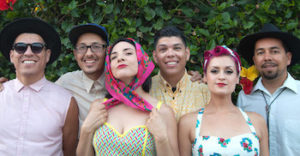
*Afro Mexicans, also known as Black Mexicans, were first celebrated on this date in 1500. They have a predominant heritage from Sub-Saharan Africa.
As a single community, Afro Mexicans include individuals descended from Black slaves brought to Mexico during the Middle Passage era in the transatlantic African slave trade, as well as others of more recent immigrant African descent, including Afro-descended persons from neighboring English, French, and Spanish-speaking countries of the Caribbean and Central America, descendants of fugitive slaves who escaped to Mexico from the Southern United States, and to a lesser extent recent immigrants directly from Africa. Enslaved Africans were brought in large numbers to Spanish America and Mexico in particular, becoming an integral part of Mexican society.
Afro-Mexicans engaged in various economic activities as slaves and as free persons. Mexico never became a society based on slavery, as in the American Antebellum Southern colonies or Caribbean islands, where plantations utilized large numbers of field slaves. At conquest, central Mexico had a large, hierarchically organized Indian population that provided largely coerced labor. Mexico's economy benefited from the African slave industry during the colonial period, particularly in Spanish cities, as domestic workers, artisans, and laborers in textile workshops. Although Mexico has celebrated its mixed Indigenous and white-European roots, mestizaje, Africans' presence and contributions have, until recently, not been part of the national discourse. Increasingly, the historical record has been revised to take account of Afro-Mexicans' long presence in Mexico.
Enslaved West Africans and indigenous Mexicans in the 1500s built the fort complex at San Juan de Ulúa. In 2017, the fort and the town of Yanga were declared "Sites of Memory" by INAH and UNESCO as part of The Slave Route Project. Black slaves had roots in Africa; some came from other Spanish territories, particularly the Caribbean. Africans mainly came from Western Sudan and the ethnic Bantu. This is known through various documents, such as sales transcripts. Originally, the slaves came from Cape Verde, Guinea, and Angola. Afro-Mexicans are most concentrated in largely isolated communities, including the populations of the Costa Chica of Oaxaca and Guerrero, Veracruz, and in some cities in northern Mexico.
According to recent DNA studies, most Mexicans have a small amount of African, averaging to about 5% African DNA. Therefore, Afro-Mexican refers to those Mexicans with above-average levels of specifically West African ancestry that is noticeable in their appearance. The history of Africans in Mexico has been lesser known due to their small numbers as a proportion of the overall population of Mexico, irregular intermarriage with other Mexican ethnic groups, racism in Mexico and other Latin-American countries, and Mexico's tradition of defining itself as a "Mestizo" country. A word is widely understood as "mixed Spanish and Native Mexican.”
According to Johns Hopkins University, 200,000 enslaved Africans landed in what later became modern Mexico. The slaves, who were mostly male, intermarried with indigenous women; in other cases, the Spanish raped the female slaves. Spanish colonists created an elaborate racial caste system, classifying people by racial mixture. This system broke down in the late colonial period; the legal notion of race was eliminated after Independence. The creation of Mexican national identity, especially after the Mexican Revolution, emphasized Mexico's Indigenous Amerindians and Spanish European heritage, excluding Africans' history and contributions from Mexico's national consciousness. In 1992, the Mexican government officially recognized African culture as one of the three major influences on the culture of Mexico, the others being Spanish and Indigenous.
The genetic legacy of Mexico's once significant number of colonial-era African slaves is evidenced in non-Black Mexicans as trace amounts of sub-Saharan African DNA are found in the average Mexican. Evidence of this long history of intermarriage with Mestizo and Indigenous Mexicans is also expressed in the 2015 census, which showed that 64.9% (896,829) of Afro Mexicans also identified as Indigenous Amerindian Mexicans. It was also reported that 9.3% of Afro Mexicans speak an indigenous Mexican language. About 1.2% of Mexico's population has significant African ancestry, with 1.38 million self-recognized during the 2015 Intercensus Estimate. Numerous Afro Mexicans in the 21st century are naturalized Blacks from Africa and the Caribbean. The 2015 Intercensus Estimate was the first time Afro Mexicans could identify themselves as such, marking a preliminary effort to include this identity before the 2020 census. They also comprise the Blaxican community.
The question asked on the survey was "Based on your culture, history, and traditions, do you consider yourself black, meaning Afro-Mexican or Afro-descendant?" and came about following various complaints made by civil rights groups and government officials. Some of their activists, like Benigno Gallardo, feel their communities lack "recognition and differentiation" by what he calls "mainstream Mexican culture." This, however, is largely due to the small number of Afro-descendant individuals relative to the overall Mexican population and their highly defined and isolated communities. We chose September 16 for this article because it aligns with Mexico’s independence from Spain in 1810.